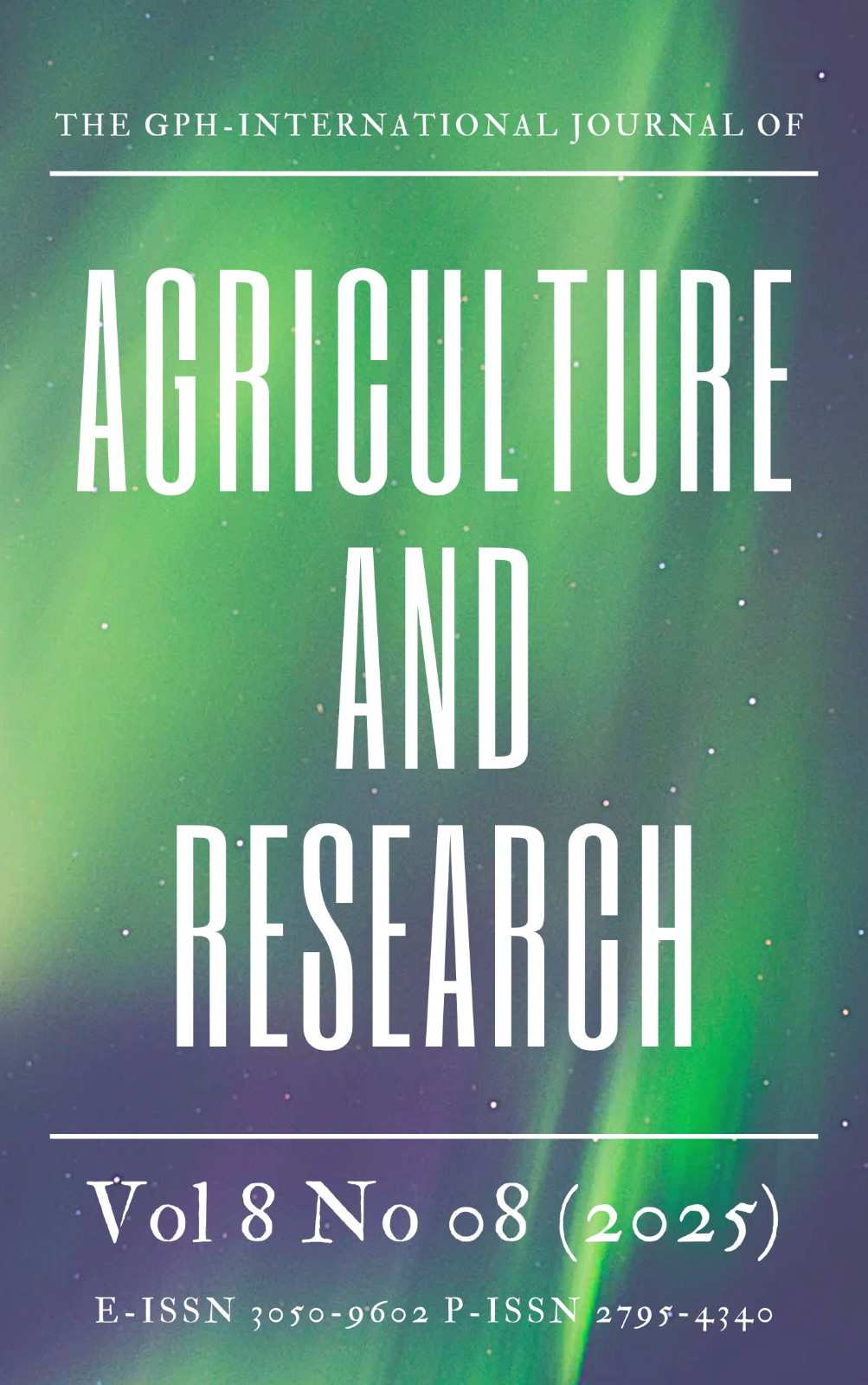EFFECT OF CLIMATE CHANGE ON SOYA BEANS (Glycine max) OUTPUT IN NIGERIA
Abstract
The study examined climate change effects on soya beans output in Nigeria. Data were collected from the Food and Agriculture Organization (FAO) and the Nigerian Meteorological Agency (NIMET) from 1981-2018. The effect of climate change was analyzed using Autoregressive Distributed Lag Bound approach, Error Correction Model and Augmented Dickey– Fuller tests for stationarity test. On the effects of climatic variables on soya beans output, the coefficient of multiple determination (R2) 0.7965, shows that about 79.65%, of the variations in soya beans output was explained by the climatic variables. F-statistics of 24.27 is significantly higher than the lower bound of 2.9 and the upper bound of 3.8 at 5% level. This indicates that there is a long run relationship between soya beans output and the climatic variables in the model. The ECM value of soya beans output is -0.126. The magnitude of the coefficient estimate of ECM suggests that 12.6% of the disequilibrium caused by previous years’ shocks converges back to the long-run equilibrium in the current year. This reveals that the speed of adjustment will adjust to the long-term equilibrium. The study recommends the need for policy makers to establish temperature monitoring systems and thresholds to preemptively address warming that could negatively impact soya beans output.
Downloads
References
Agba, D.Z., Adewara, S.O., Adama, J.I., Azer, K.T., and Atoyebi, G.O. (2017) Analysis of the Effects of Climate Change on Crop Output in Nigeria. American Journal of Climate Change. (6)1: 554-571
Anyaegbu, C.N.; Okpara, K.E.; Taweepreda, W.; Akeju, D.; Techato, K.; Onyeneke, R.U.; Poshyachinda, S.; Pongpiachan, S. (2023). Impact of Climate Change on Cassava Yield in Nigeria: An Autoregressive Distributed Lag Bound Approach. Agriculture (13, 80. https://doi.org/10.3390/ agriculture13010080
Audu, I. A. and Adie, L. A. (2018). Desertification in Northern Nigeria: Causes and Consequences. The Environmental Studies (A Multidisciplinary Journal). (1) 1 – 2: 20 -37
Ayoade, J.O. (2003). Climate Change: A synopsis of its Nature, Causes, Effects and Management, Ibadan: Vantage Publishers Limited
Chirwa, E.W. (2000). Liberalization of Food Marketing and Market Integration in Malawi. Final Report of an AERC sponsored Research Work, Presented at the Biannual Economic Research Workshop, Nairobi, Kenya. May 27, 2007.
Edet, E.O.; Udoe, P.O.; Isong, I.A.; Abang, S.O.; Ovbiroro, F.O. (2021). Impact of climate variability on yield of maize and yam in Cross River State, Nigeria: An autoregressive distributed lag bound approach. World News Natutural Science Integrated Science Journal 36: 60–74
Gbegbelegbe, S.; Alene, A.; Kamara, A.; Wiebe, K.; Manyong, V.; Abdoulaye, T.; Mkandawire, P. Ex-ante evaluation of promising soybean innovations for sub-Saharan Africa. Food Energy Security. 2019, 8, 1–16, doi:10.1002/fes3.172.
Granger, C.W.J., (1969) Investigating Causal Relations by Econometric Models and Cross-spectral Methods. Econometrica 37 (3), 424–438.
Hendry, D.F. (1986). Econometric Modelling with Co-integrated variables: An overview, Oxford Bulletin of Economic and statistical research. (48) 3: 201-212
IPCC (2014), “Global climate change impacts in the United States”, Fifth assessment report of the United States Global Change Research programme, Cambridge University Press.
Kumagai, E.; Kumagai, N.; Masuya, Y.; Shimono, H. Phenotypic Plasticity Conditions the Response of Soybean Seed Yield to Elevated Atmospheric CO2 Concentration. Plant Physol. 2015, 169, 2021–2029, doi:10.1104/pp.15.00980.
Manufacturing Sector Report, (2015). Overview of GDP growth in Nigeria; Analysis for Future Improvement through Economic diversification. National Economic Summit Conference, 2014.
Muller, C. (2009). Climate Change Impact on Sub-Saharan Africa? An Overview and Analysis of Scenarios and Models in German Development Institute Discussion Paper 3/2009.
Nkoro, E.; Uko, A.K. (2016). Autoregressive Distributed Lag (ARDL) cointegration technique: Application and interpretation. J. Stat. Econom. Methods (5) 63–91
Odjugo, P.A.O. (2010). Global and Regional Analysis of the causes and Rate of Climate Change. In R. N. C. Anyadike, I. A. Madu and C. K. Ajaero (Eds).
Oludare, S. D. and Khaldoon, A. M. (2020). Modelling the Impacts of Climate Change on Soybeans Water Use and Yields in Ogun-Ona River Basin, Nigeria. Agriculture. (10), 593; Pp. 1-24 doi:10.3390/agriculture10120593
Organization for Economic Cooperation and Development (OECD) (2017) Crop Production (Indicator). OECD, Paris.
Steduto, P.; Hsiao, T.C.; Fereres, E.; Raes, D. Crop. Yield Response to Water; FAO Irrigation and Drainage: Rome, Italy, 2012.
Zakari D.M., Mohammed, A.B. Medugu, N.I.and Sandra, I. (2014) Impact of Climate Change on Yam Production in Abuja, Nigeria. International Journal of Science, Environment and Technology, (3) 2: 1 – 16
Author(s) and co-author(s) jointly and severally represent and warrant that the Article is original with the author(s) and does not infringe any copyright or violate any other right of any third parties, and that the Article has not been published elsewhere. Author(s) agree to the terms that the GPH Journal will have the full right to remove the published article on any misconduct found in the published article.

























